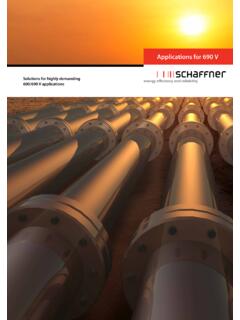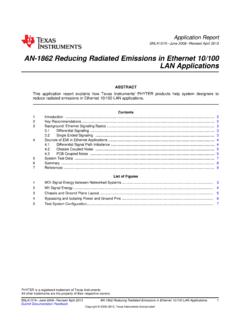Transcription of 1 Basic in EMC and Power Quality - schaffner.com
1 1 Basic in EMC and Power Quality 2013. basics in EMC / EMI and Power Quality Introduction, Annotations, Applications 2 Basic in EMC / EMI and Power Quality basics in EMC and Power Quality I Introduction 5. 1 Sources of electromagnetic signals 5. Natural and technical sources of electromagnetic signals 5. Definition of noise 5. Frequency ranges 5. Differential-mode noise 6. common -mode noise 6. Noise propagation 6. Coupling methods 6. Radiation 6. 2 Legal requirements 7. Global legislation 7. CE marking for the European Union 7. CCC and CQC approvals for China 8. FCC registrations for the USA 8. EMC framework in Australia/New Zealand 9. VCCI registrations for Japan 9. Other international requirements 9. EMC standards 9. Standard classification 10. common limit lines 12. Safety approvals 12. EMC testing as a service 13.
2 The test 13. 3 EMC measurements 13. Emission 13. High-frequency (HF) radiated emission 13. High-frequency conducted emission 14. Discontinuous interference (clicks) 15. Mains harmonics 16. Voltage fluctuations and flicker 16. Immunity 17. RF immunity 17. Conducted immunity 18. Radiated immunity 19. Transient immunity 19. Electrostatic discharges (ESD) 19. Electrical fast transients (bursts) 20. Surge 21. Power magnetic fields 21. Supply network 21. Basic in EMC / EMI and Power Quality 3. 4 Noise suppression 23. Conceptual EMC 23. Shielding 23. Shielded housings 23. Shielded cables 23. Grounding 24. Grounding concepts 24. Earthing 24. Suppression components 24. Chokes 25. Capacitors 26. Filters 27. Filter attenuation 28. 5 Power Quality 28. Definition 28. Frequency ranges 29. Reactors in drive systems 29.
3 Need for protection 29. Overview of uses 30. Line input 30. Output solutions for motor drives 31. dv/dt voltage potential jumps in relation to the time 31. Voltage overshoots and voltage peaks 31. Additional losses in the motor 32. Cable shields and parasitic earth currents 32. Bearing damage 32. Acoustic noise levels 33. Solutions for output problems 33. II Annotations to filter specifications 35. 1 Filter ratings 35. Electrical specifications 35. Current 35. Voltage 35. Frequency 36. DC resistance 36. Discharge resistors 36. MTBF 36. Mechanical specifications 36. Mechanical tolerances 36. Filter terminals and cable cross-sections 37. Torque specifications 38. 4 Basic in EMC / EMI and Power Quality Environmental requirements 38. RoHS 38. Vibration and bump testing 39. Climatic classification 39. 2 Safety requirements 39.
4 Type testing 39. Hipot testing 39. Leakage currents 40. Flammability classification 41. Fuses 41. 3 Power distribution networks 42. Designation of networks 42. TN network 42. TN-S system 42. TN-C and TN-C-S systems 42. TT network 42. IT network 42. Network with one grounded phase 43. 4 Installation instructions 43. Installation of filters 43. Cable connection and routing 44. Shield connections 44. Cable routing 44. EMC planning 44. III Typical applications 45. 1 Choke applications 45. 2 Power supply applications 45. 3 Medical applications 46. 4 Test and measurement equipment 47. 5 Motor drive applications 47. 6 Energy regeneration 47. 7 Renewable energies 49. 8 NEMP applications 51. 9 TEMPEST applications 51. 10 Communication equipment 51. 11 Shielded rooms 51. IV Abbreviations 52. Basic in EMC / EMI and Power Quality 5.
5 I Introduction 1 Sources of electromagnetic signals The first important frequency range is the range around the Power network frequency, which in Europe is 50 Hz. Most loads connected Electromagnetic signals are the result of electrical currents and to the Power network are non-linear loads, , they draw a current voltages. Whenever electricity is used to drive equipment, an that does not follow the sinusoidal voltage. Non-linear loads have electromagnetic signal ensues as well. These signals can be used to the characteristic of generating additional currents at multiples of transmit information from one point to the next, or they can simply the network frequency. These currents are called harmonics and are be a byproduct of the operation of equipment. Where the signals generally considered up to the 40th or 50th order.
6 In other words, are unintended, we speak of electromagnetic noise. It is this noise our first frequency range starts at 50Hz and ends at 2 kHz or kHz. that can cause equipment to malfunction, and manufacturers must For 60 Hz networks, the range goes from 60 Hz to kHz or 3 kHz. therefore take steps to reduce the effects of noise. From the end of the harmonics range to 9 kHz, we have a frequency In this chapter we will mainly look at the unwanted noise, but for range that is not currently regulated. We will come back to this in the purpose of explanation we will sometimes also refer to intended the Power Quality chapter. Above 9 kHz, the high-frequency range signals. Most people are more aware of the intended signal transmis- starts. This range is also called the radio-frequency or RF range. sion than of unintended signals.
7 Radio frequency is the collective term for all frequencies from a few kilohertz to several gigahertz. EMC standards limit the frequency Natural and technical sources of electromagnetic signals range to 400 GHz on the upper end, although test methods for such To a certain extent, electromagnetic signals are natural phenomena. frequencies have not been defined yet. Current standards define One of the best known phenomena is a lightning strike, which is testing methods from 9 kHz to 1 GHz, and some newer versions go nothing more than a huge current flowing from a cloud towards up to 2 GHz or higher. The technical progress today is faster than the Earth. This current causes high electromagnetic fields. Other than development of standards. Computers and communication equip- that, we also have atmospheric radiation.
8 These types of signals are ment use fundamental frequencies that are already above 2 GHz. comparably small and are generally not considered for EMC on an Looking at harmonic frequencies, even a 2 GHz upper limit is no lon- equipment level. ger sufficient to cover RF problems. More important for our purposes are the technical sources of elec- The RF range is generally split into a conducted and a radiated tromagnetic signals. Electrically powered equipment, as already range. For the lower part of the RF range, noise is expected to travel mentioned, is one such source. In this category we can identify two along lines rather than radiate from the equipment. The main reason main sources of electromagnetic noise: Power supplies and motor for this is that the required antenna structures are bigger for lower drive systems.
9 On the other hand, we also purposely generate sig- frequencies. In other words, the physical size of most equipment is nals in order to transmit them over a distance, as in a TV station. simply not sufficient to radiate low frequency noise. While an exact With the increase of communication and especially wireless services, frequency cannot be defined, the standards generally set the con- this element is becoming more and more important. ducted RF range from 150 kHz to 30 MHz. Some standards also start at the lower frequency of 9 kHz. The radiated range then starts at 30. Definition of noise MHz. The upper limit of this range depends on the standard, but it The intended generation of signals for information transmission is will generally be about 1 GHz, for some products 2 or 3 GHz. To sum- not considered noise, but it does have an impact on the overall EMC marize, we have the following ranges: of equipment.
10 This will come up again in a later chapter. In this chap- ter, our focus is on unwanted noise signals and their characteristics. Harmonics LF range Conducted Conducted Radiated Radiated RF range RF range RF range RF range Frequency ranges A key characteristic of electromagnetic noise is its frequency. The 50 Hz 2 kHz 2 Hz 9 kHz 9 kHz 150 kHz 150 kHz 30 MHz 30 MHz 1/2/3 GHz Above 3 GHz EMC standards generally cover the range from 0 Hz to 400 GHz. 60 Hz kHz kHz 9 kHz *. Currently, however, not all frequency ranges are completely regu- Regulated range Regulated range for some products Unregulated range Upper limit depends on product lated. Definition of frequency ranges 6 Basic in EMC / EMI and Power Quality The defined testing methods for these frequency ranges are When we look at the measurements later, we will see that the result explained in a later chapter.




